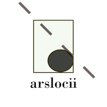arslocii
placeness as art


arslocii
placeness as art


Quest for artistic endeavor
Arslocii are the places for art, literally. They are occasionally in the least-expected locations but, keep alert, they could be just beyond the county line or in your nearest-neighbor state. Happily, they are all within reach.
You could say that art is all around, waiting to be noticed. It does often depend on the beholder. But, too, there are intentional sites, places of real vision and transcendence, where the meaningful placement of architecture, art and/or designed landscape in their environment results in a singular and wholly formed work whose parts are inseparable, producing a heightened creative unity – in other words, a “placeness.” These intentional sites – arslocii – have a special pairing of the manmade with nature, or sometimes even manmade with manmade; the effect being a symbiosis in which neither one stands out or alone, nor would be as meaningful, beautiful or inevitable without the other. It’s an interdependence of aesthetics that goes beyond, thankfully, human dominance over nature or setting, because that has never had much grace.
Probasco Haus Press has set itself a challenge and a mission: to discover these sites, explore the meaningful convergences and engage with the spiritual aspects of the merger – a primal connection, a visceral understanding. Then, we will write about our discoveries, as a way of figuring out how these pairings complement and enhance each other, becoming something greater.
One of the inspirations for this search was a visit to Stonehenge about fifteen years ago at the Winter Solstice. Freezing our asses off standing in the blustery winds that whip across the Salisbury Plain, we were mesmerized by the power of place. It was an early arslocii, before we were even cognizant of the concept, really. The power of the massive stones, the circularity, the placement on the highest point overlooking a vast landscape, the way the low sun played peek-a-boo with the stone arcade: the image is still vivid in our minds. Sadly, we were not permitted to stay until sunset to see the real magic of the interaction of trilithons with fading light. However, the stage was now set for trying to feel that connection again – of purposeful structure interplaying with its environment.
Our quests go something like this: We do a lot of preliminary research about an area we want to visit, searching for modern architecture, landscapes by known designers or artists, sculpture parks and site-specific artworks. Our taste is for the less ordinary, the less easily understood or, sometimes, the less easy to get to. Some places are nexuses, some are isolated and can feel weird. We map it out; we establish itineraries. We operate in a very focused way. But we hope, always, that serendipity alters our best-laid plans; we welcome encountering something other than what we came for. It’s about the finding; it’s about the journey.
We call what we do a kind of vision quest or, more appropriately, a visual quest. So far, the most memorable finds are those that have a primitive essence, an awe-factor difficult to explain. (And now, here we are trying to explain it.) We think, rather, that we will describe them as well as we can and leave the explanations to the sites or the artists who made them. We are just guides, using our instincts to create paths to signs of intelligence, markers of merit. We believe this to be a worthy quest in a world where so much is obvious, in your face and uninspired. Break out from the predictable, easy and safe; look to the unique and be thankful for the creative. It is rare, but real.










Links
arslocii, a creation of Probasco Haus Press
copyright © 2010 Probasco Haus Press LLC



